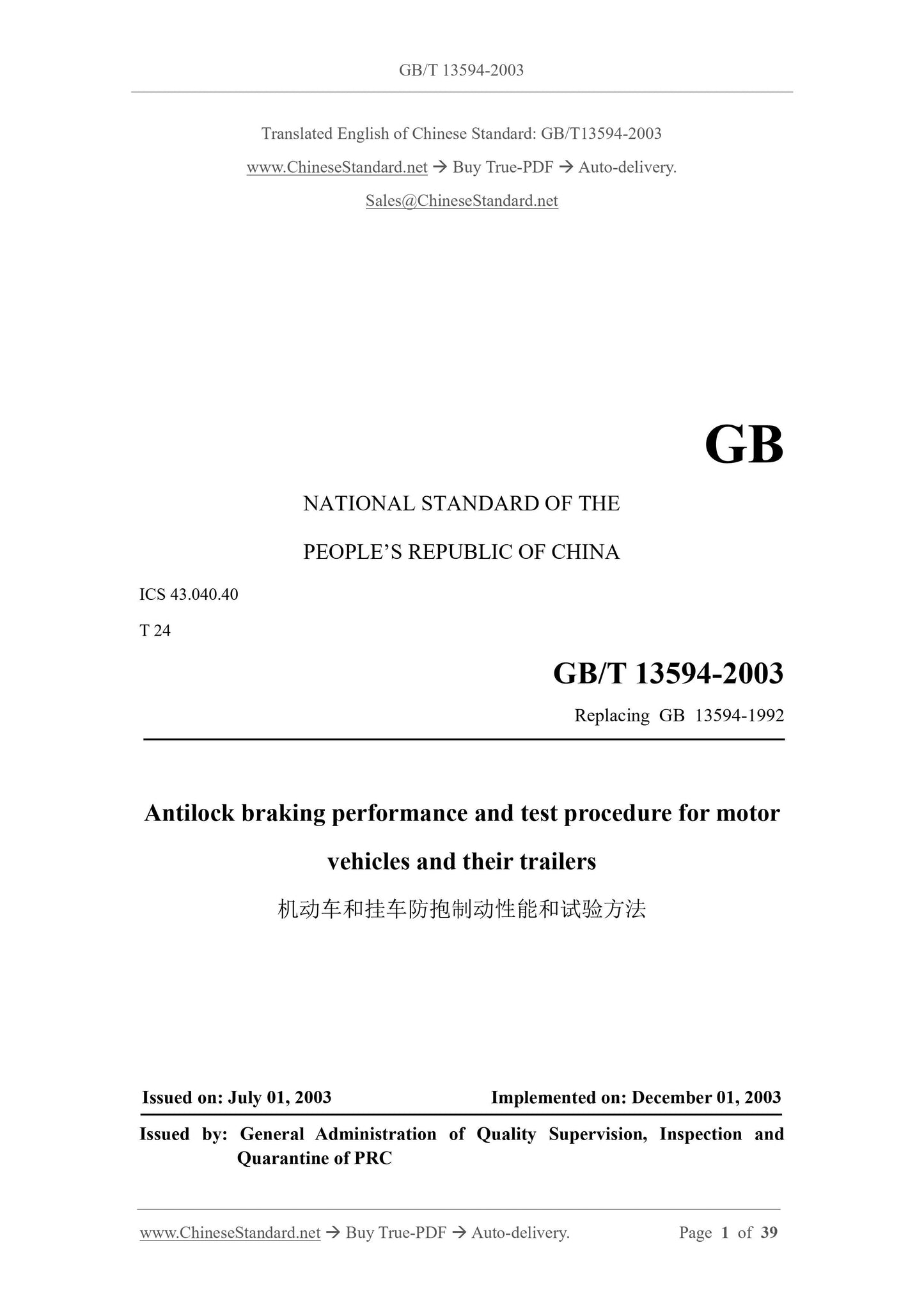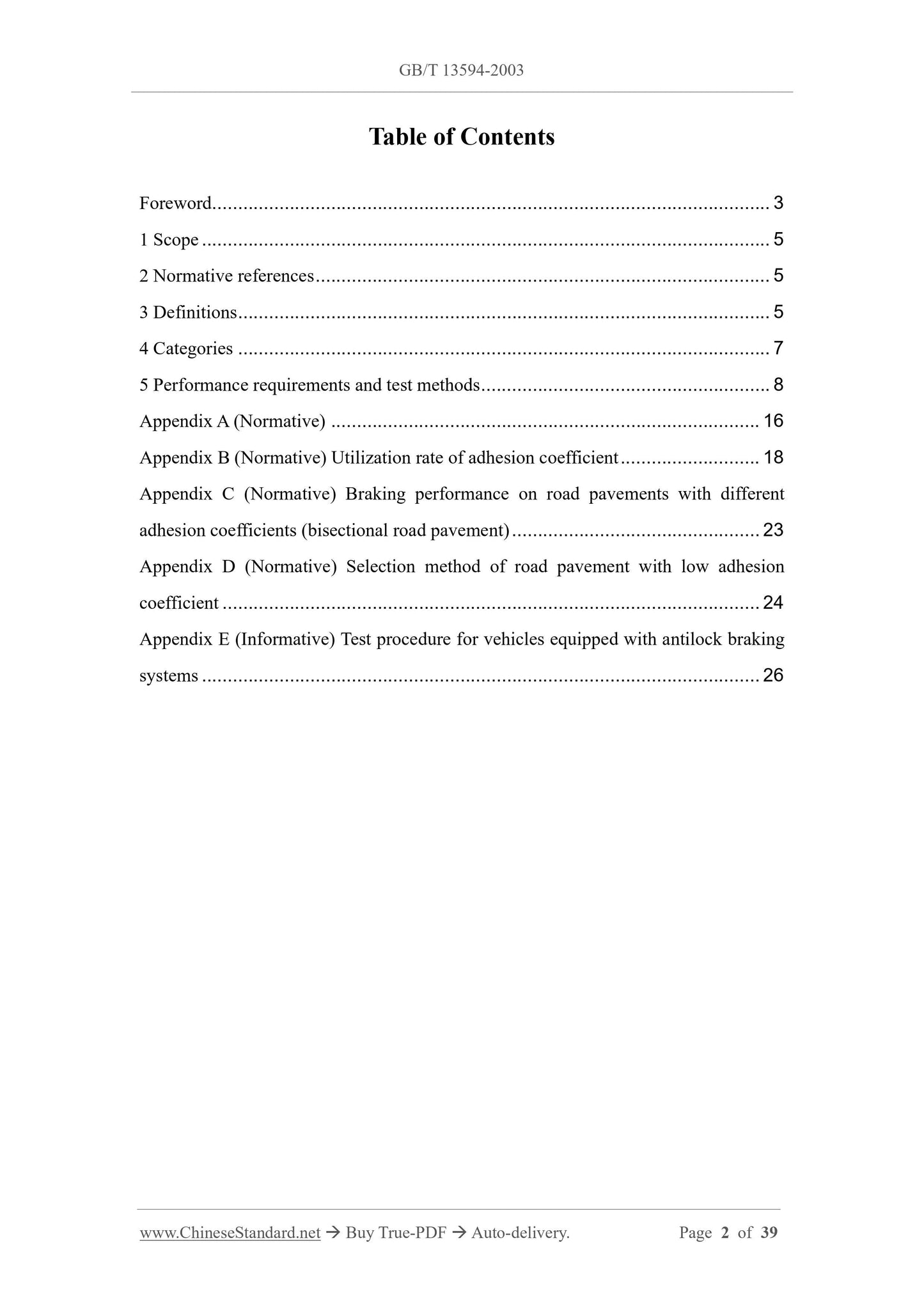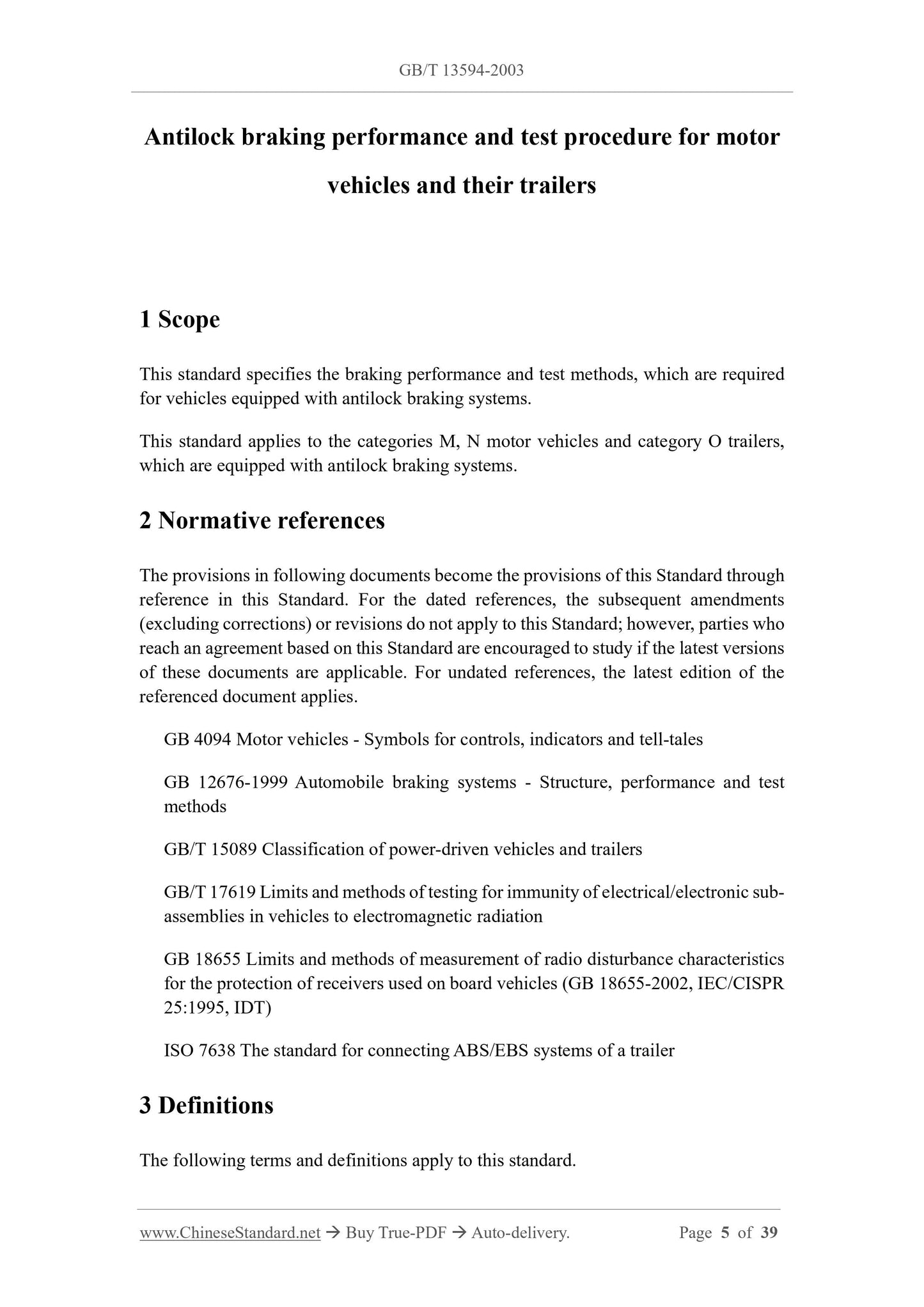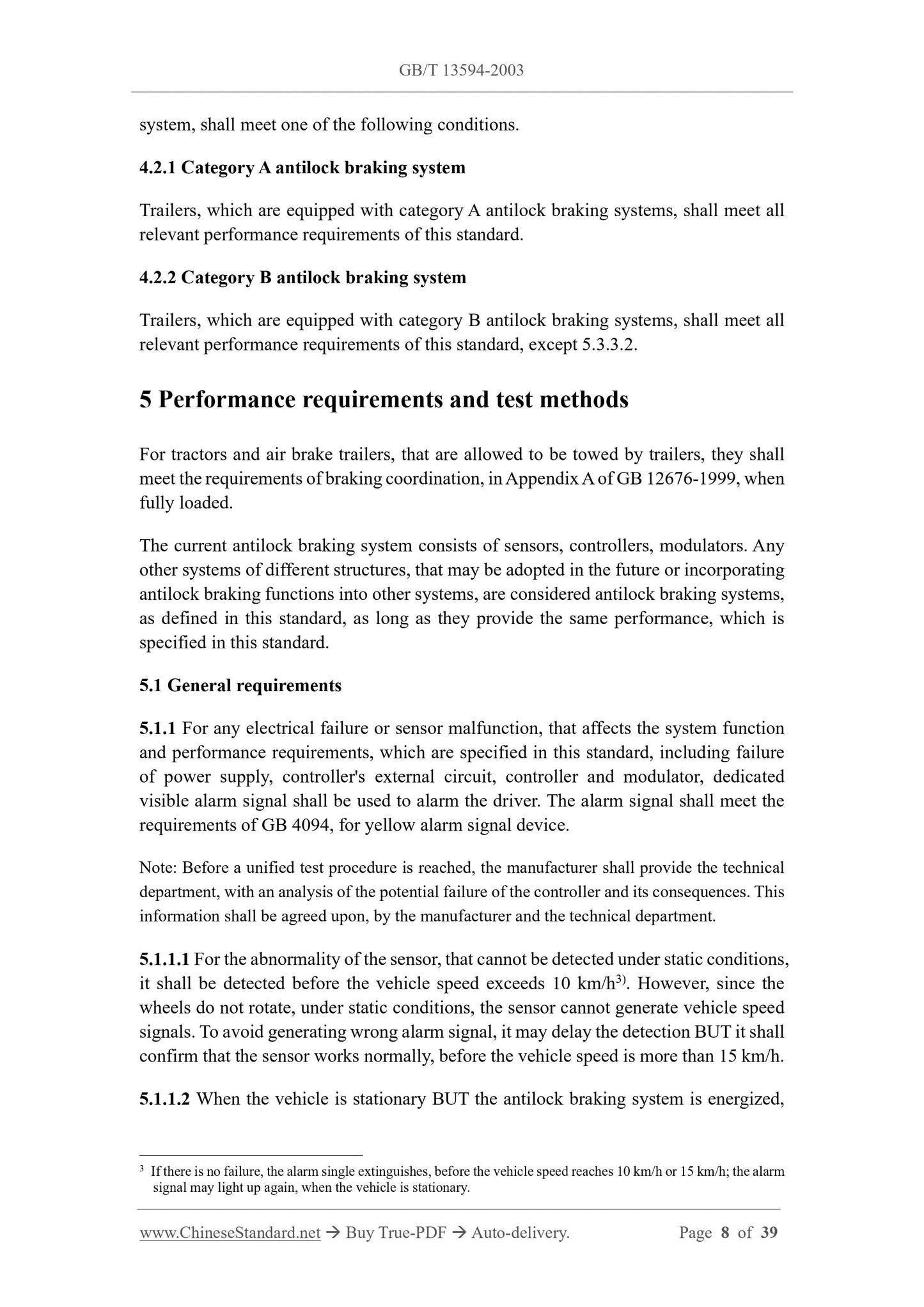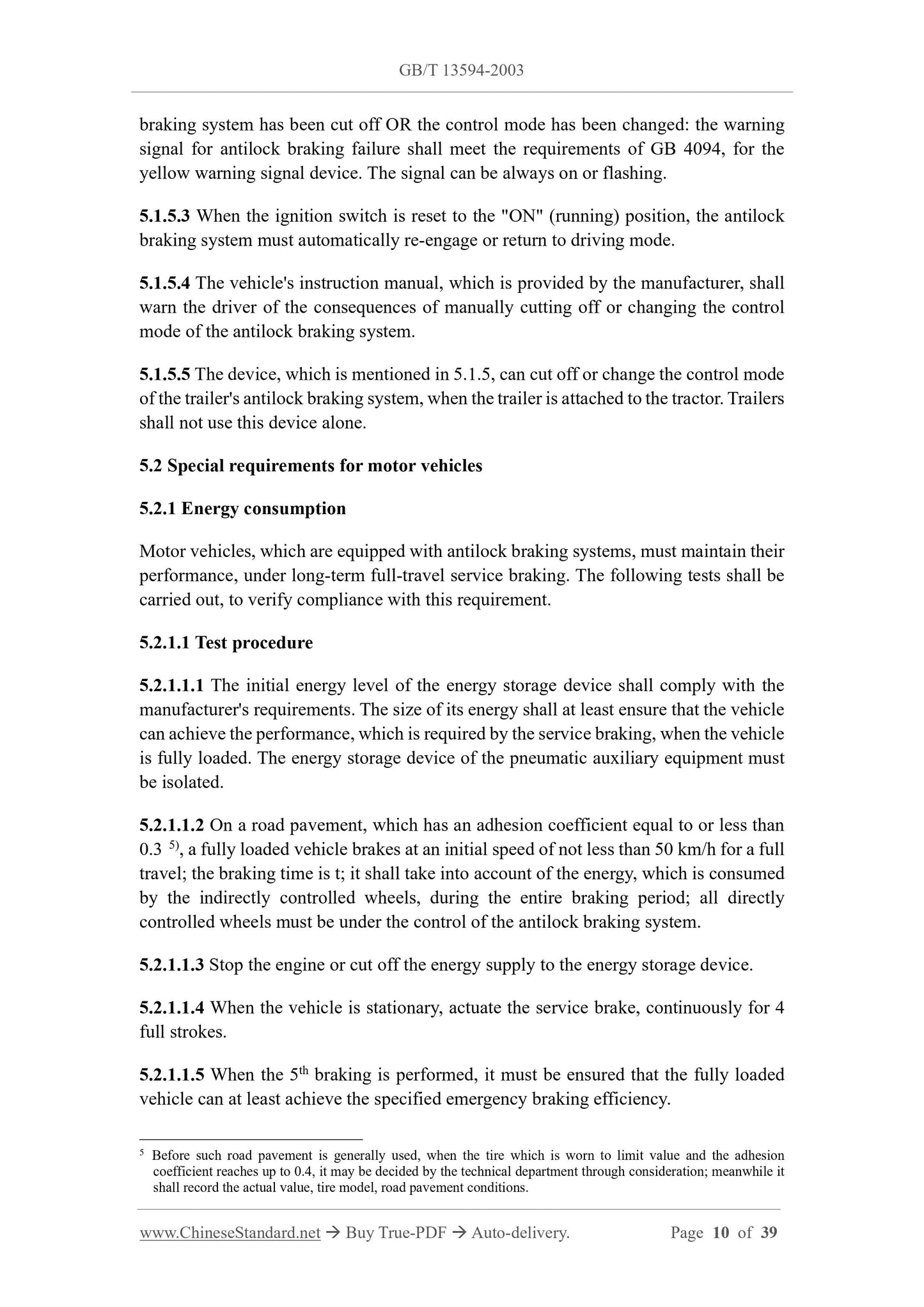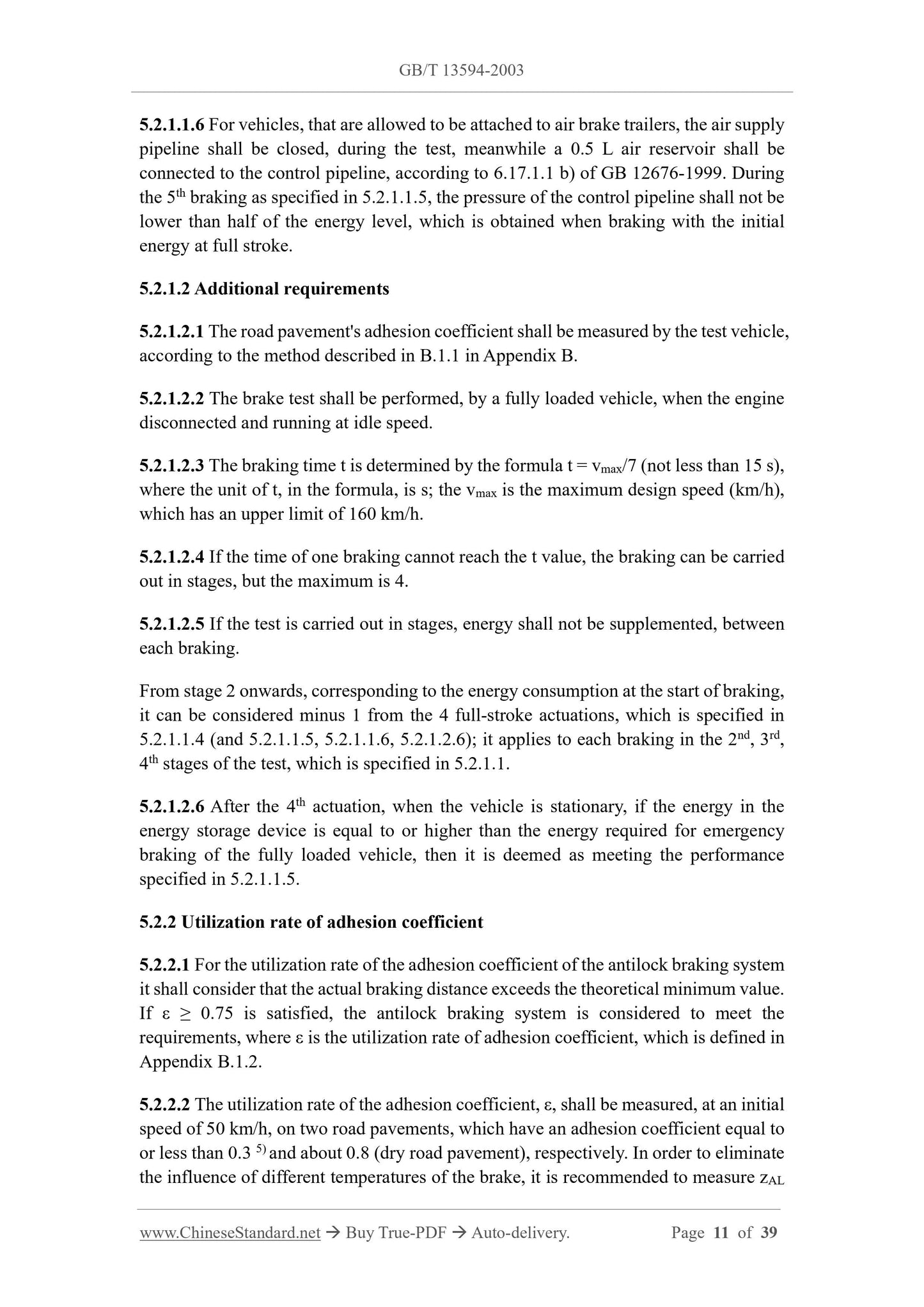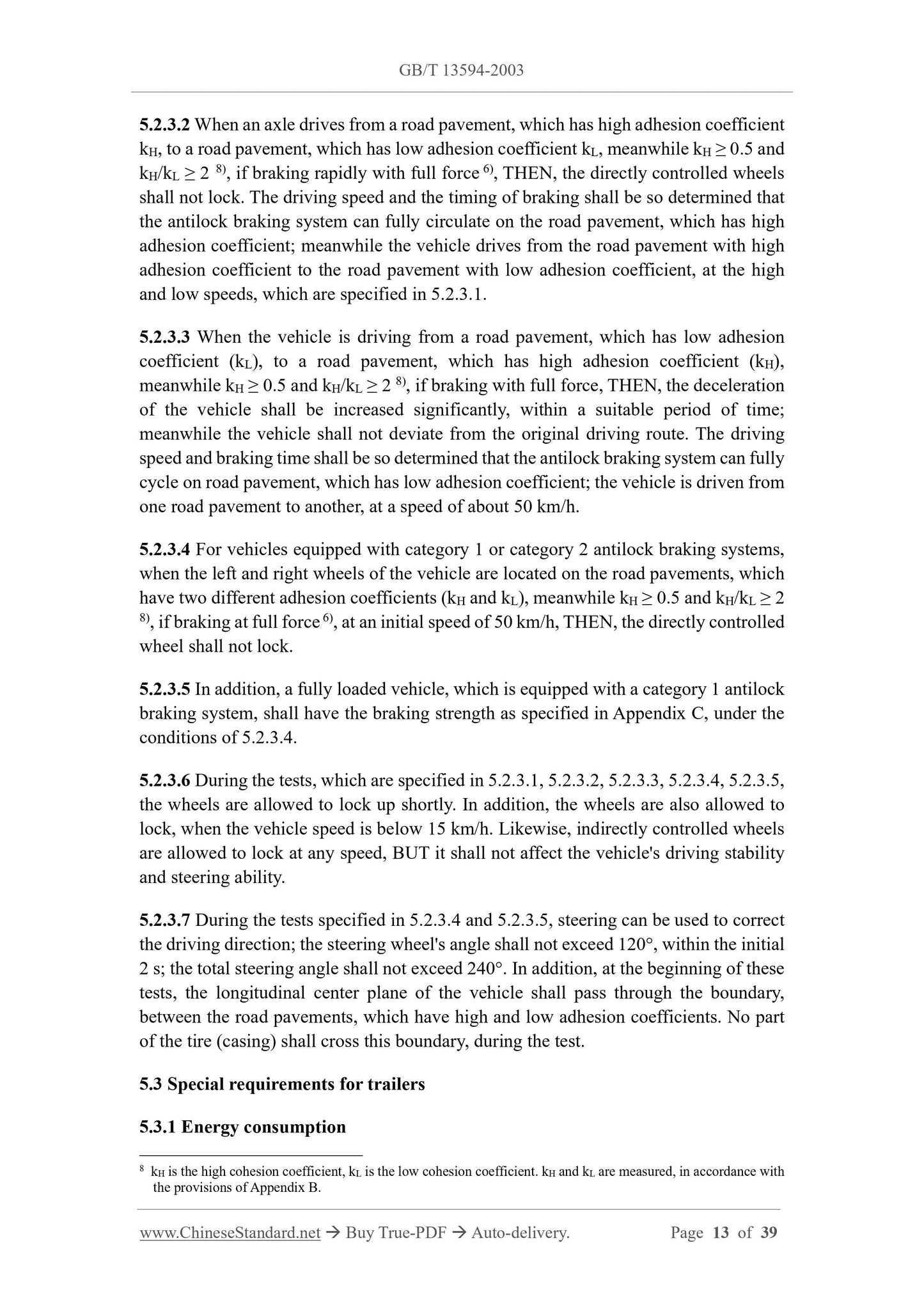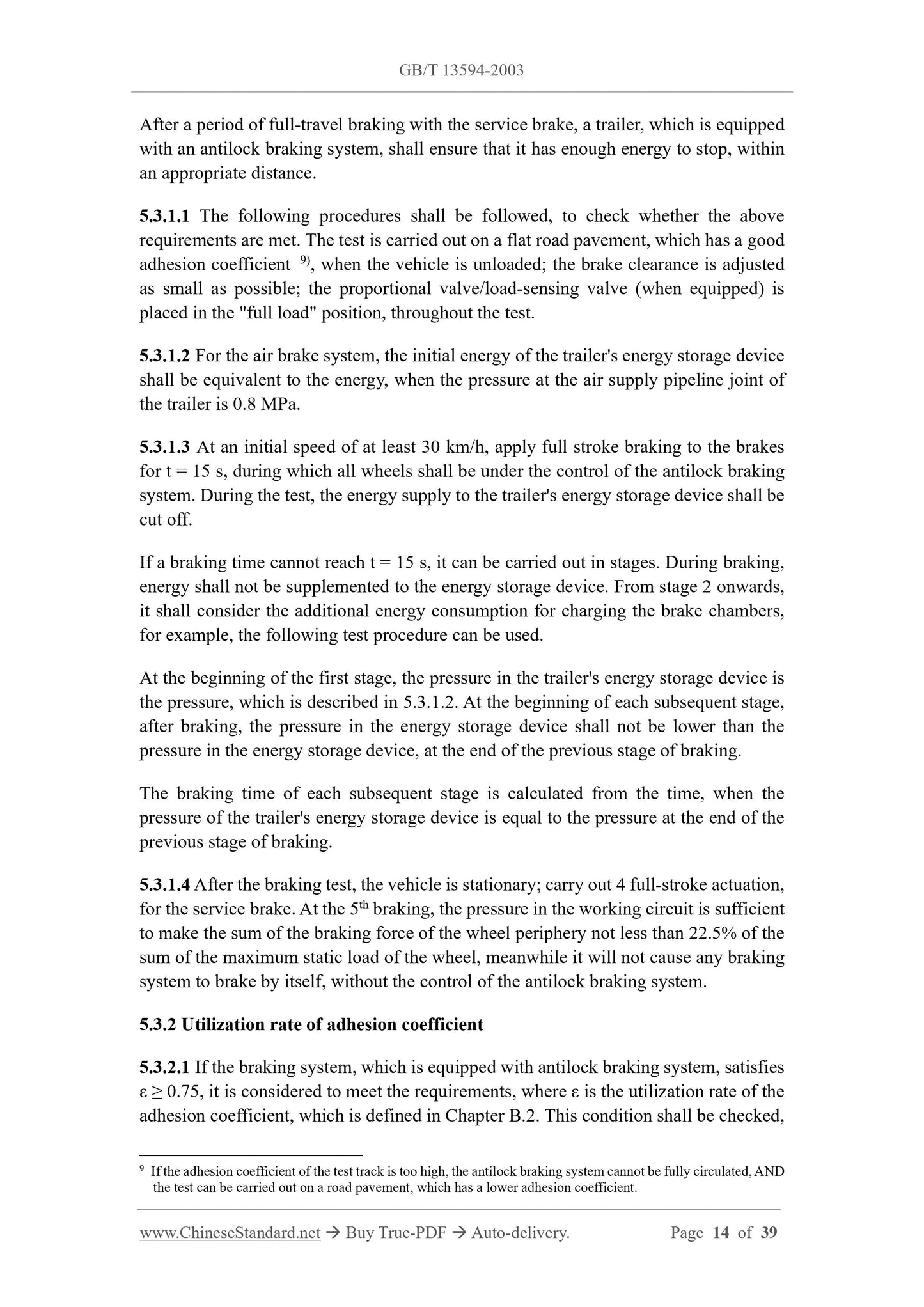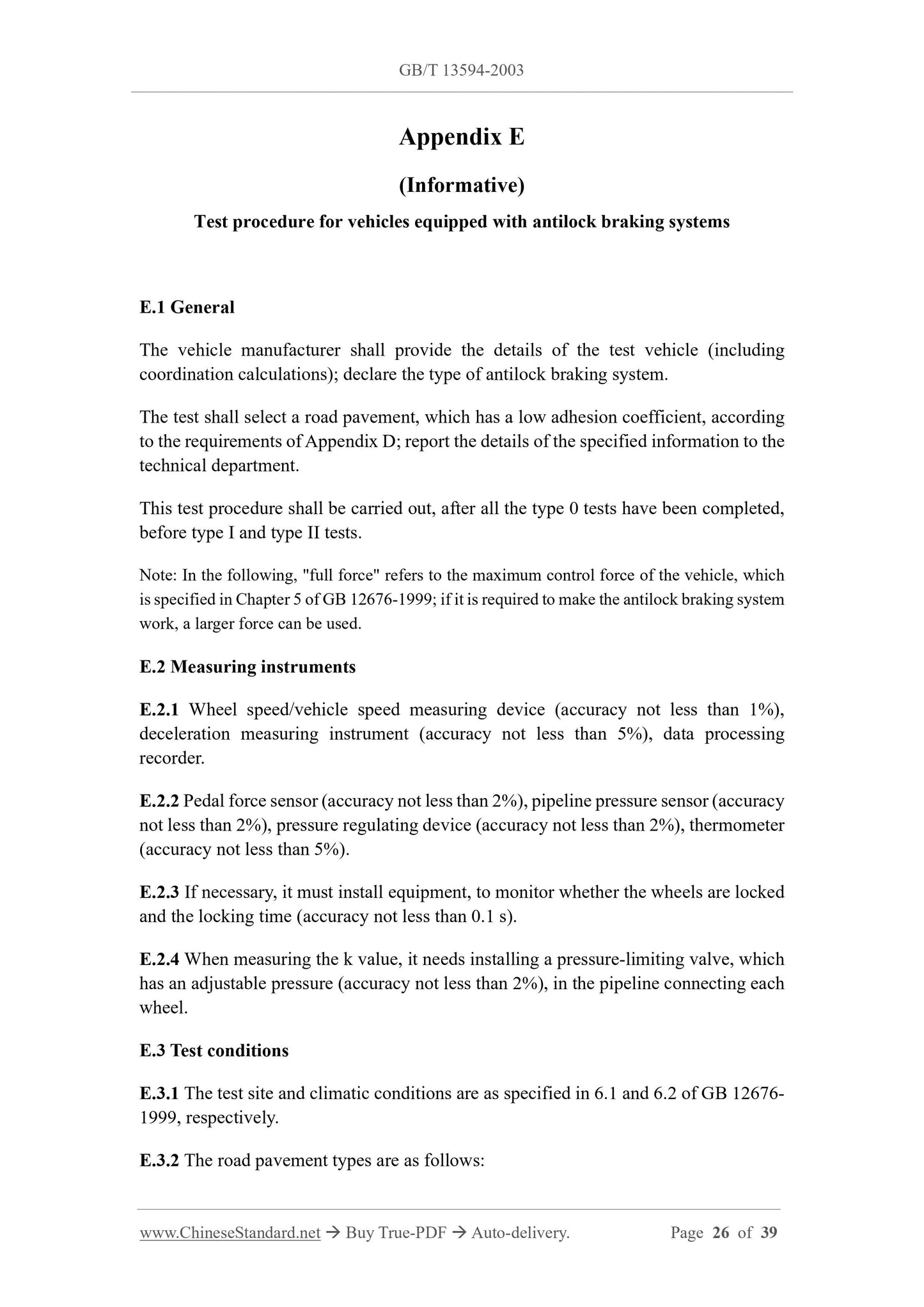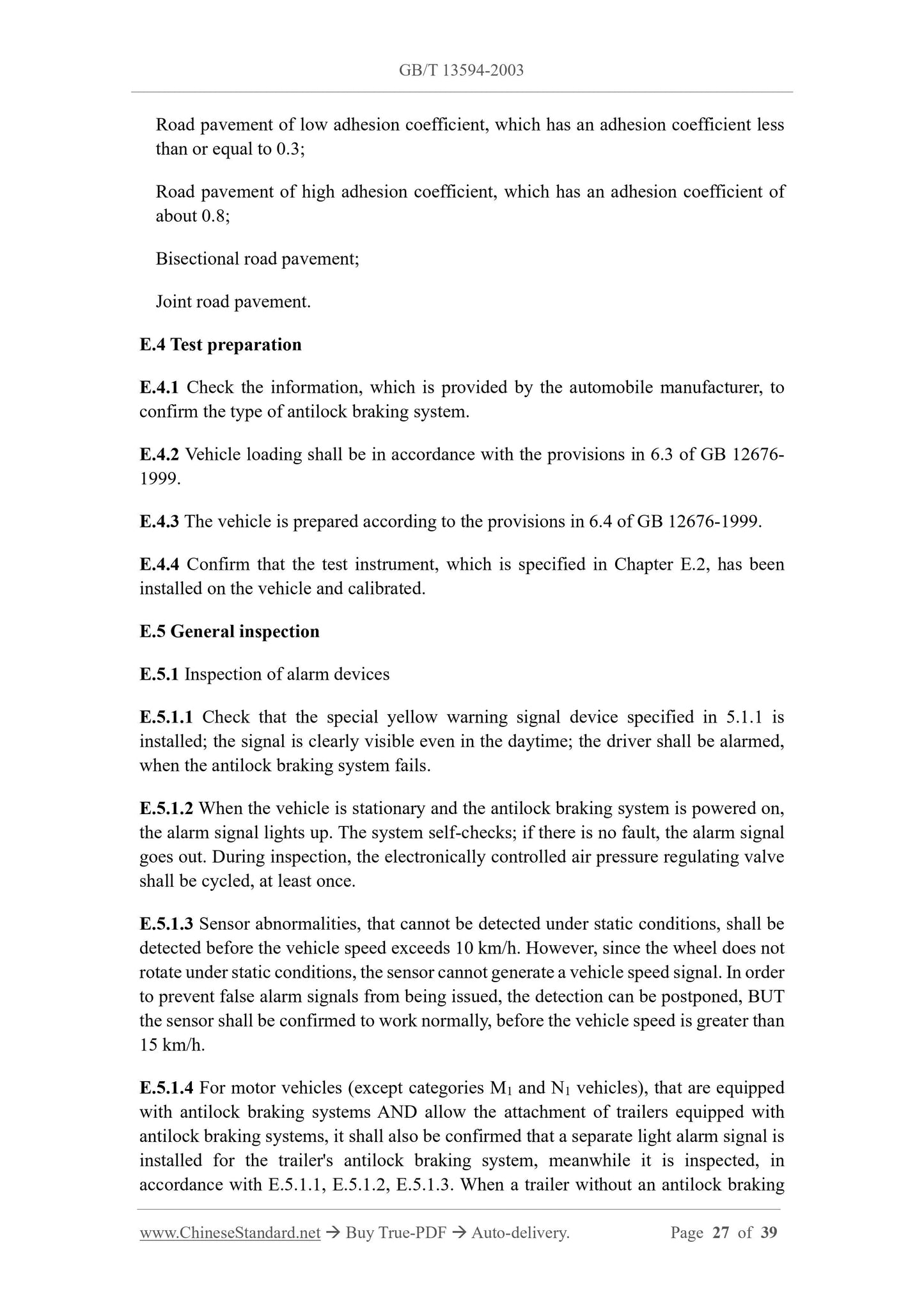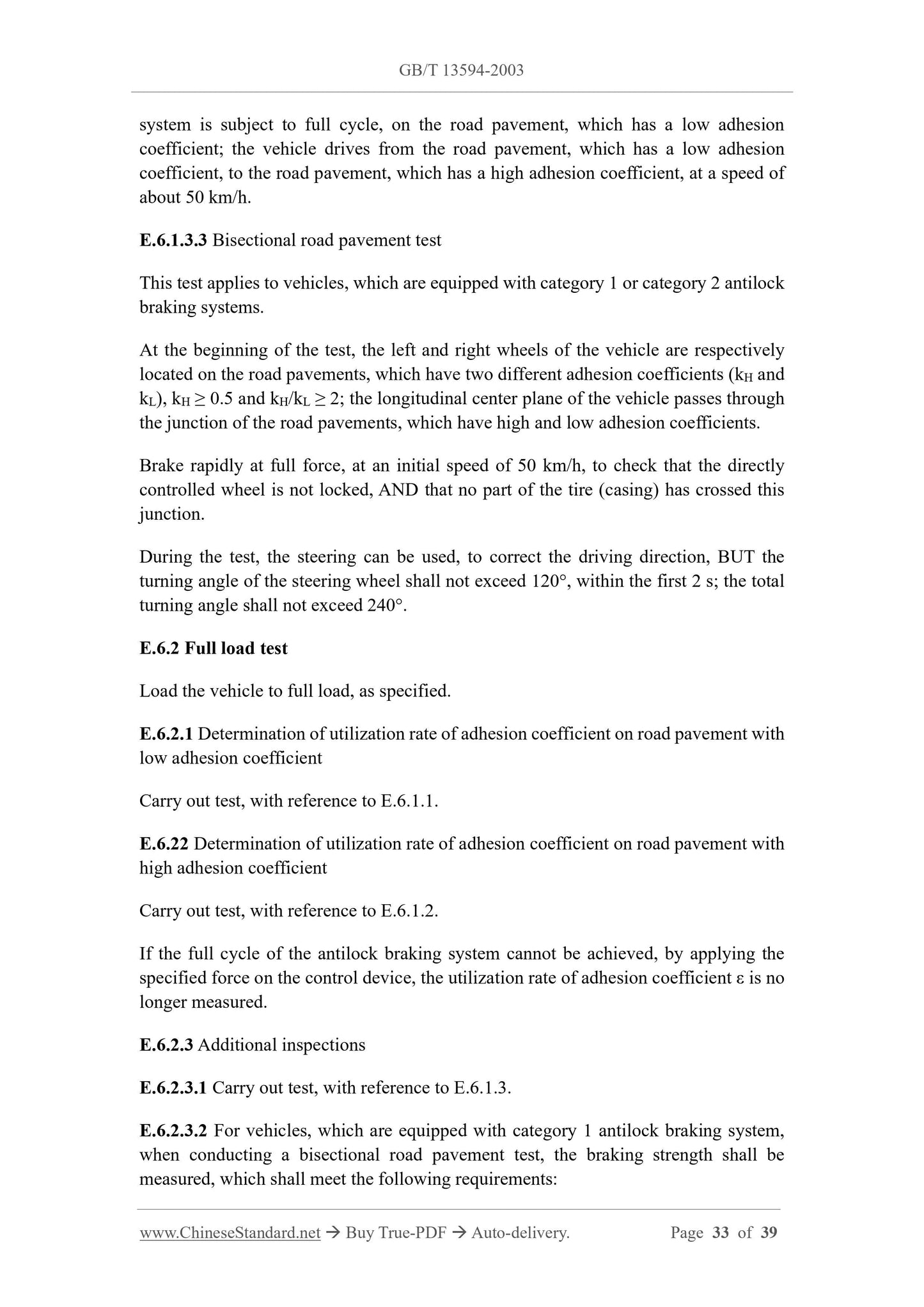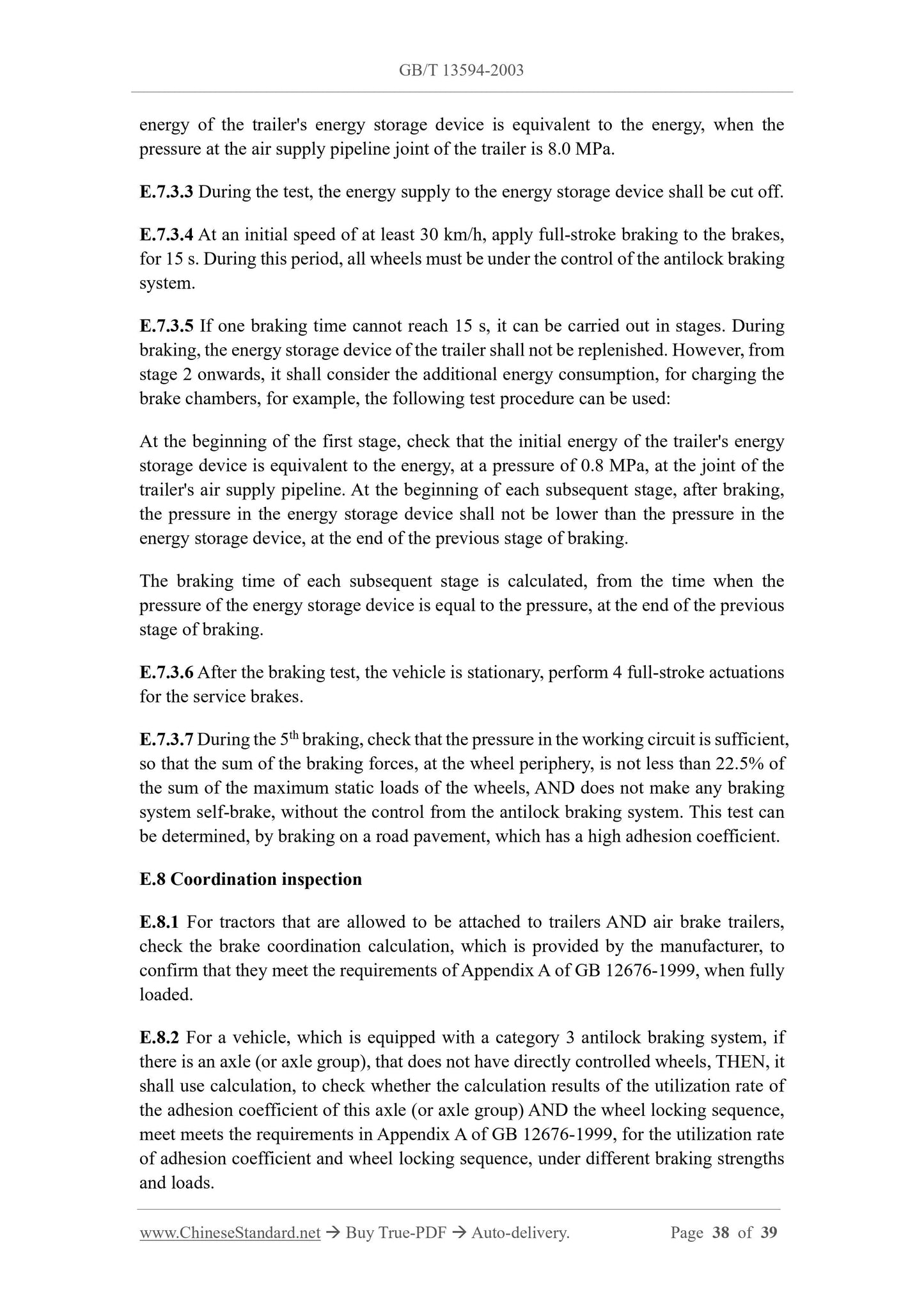1
/
von
12
PayPal, credit cards. Download editable-PDF and invoice in 1 second!
GB/T 13594-2003 English PDF (GBT13594-2003)
GB/T 13594-2003 English PDF (GBT13594-2003)
Normaler Preis
$275.00 USD
Normaler Preis
Verkaufspreis
$275.00 USD
Grundpreis
/
pro
Versand wird beim Checkout berechnet
Verfügbarkeit für Abholungen konnte nicht geladen werden
Delivery: 3 seconds. Download true-PDF + Invoice.
Get QUOTATION in 1-minute: Click GB/T 13594-2003
Historical versions: GB/T 13594-2003
Preview True-PDF (Reload/Scroll if blank)
GB/T 13594-2003: Antilock braking performance and test procedure for motor vehicles and their trailers
GB/T 13594-2003
NATIONAL STANDARD OF THE
PEOPLE’S REPUBLIC OF CHINA
ICS 43.040.40
T 24
Replacing GB 13594-1992
Antilock braking performance and test procedure for motor
vehicles and their trailers
ISSUED ON: JULY 01, 2003
IMPLEMENTED ON: DECEMBER 01, 2003
Issued by: General Administration of Quality Supervision, Inspection and
Quarantine of PRC
Table of Contents
Foreword ... 3
1 Scope ... 5
2 Normative references ... 5
3 Definitions ... 5
4 Categories ... 7
5 Performance requirements and test methods ... 8
Appendix A (Normative) ... 16
Appendix B (Normative) Utilization rate of adhesion coefficient ... 18
Appendix C (Normative) Braking performance on road pavements with different
adhesion coefficients (bisectional road pavement) ... 23
Appendix D (Normative) Selection method of road pavement with low adhesion
coefficient ... 24
Appendix E (Informative) Test procedure for vehicles equipped with antilock braking
systems ... 26
Antilock braking performance and test procedure for motor
vehicles and their trailers
1 Scope
This standard specifies the braking performance and test methods, which are required
for vehicles equipped with antilock braking systems.
This standard applies to the categories M, N motor vehicles and category O trailers,
which are equipped with antilock braking systems.
2 Normative references
The provisions in following documents become the provisions of this Standard through
reference in this Standard. For the dated references, the subsequent amendments
(excluding corrections) or revisions do not apply to this Standard; however, parties who
reach an agreement based on this Standard are encouraged to study if the latest versions
of these documents are applicable. For undated references, the latest edition of the
referenced document applies.
GB 4094 Motor vehicles - Symbols for controls, indicators and tell-tales
GB 12676-1999 Automobile braking systems - Structure, performance and test
methods
GB/T 15089 Classification of power-driven vehicles and trailers
GB/T 17619 Limits and methods of testing for immunity of electrical/electronic sub-
assemblies in vehicles to electromagnetic radiation
GB 18655 Limits and methods of measurement of radio disturbance characteristics
for the protection of receivers used on board vehicles (GB 18655-2002, IEC/CISPR
25:1995, IDT)
ISO 7638 The standard for connecting ABS/EBS systems of a trailer
3 Definitions
The following terms and definitions apply to this standard.
system, shall meet one of the following conditions.
4.2.1 Category A antilock braking system
Trailers, which are equipped with category A antilock braking systems, shall meet all
relevant performance requirements of this standard.
4.2.2 Category B antilock braking system
Trailers, which are equipped with category B antilock braking systems, shall meet all
relevant performance requirements of this standard, except 5.3.3.2.
5 Performance requirements and test methods
For tractors and air brake trailers, that are allowed to be towed by trailers, they shall
meet the requirements of braking coordination, in Appendix A of GB 12676-1999, when
fully loaded.
The current antilock braking system consists of sensors, controllers, modulators. Any
other systems of different structures, that may be adopted in the future or incorporating
antilock braking functions into other systems, are considered antilock braking systems,
as defined in this standard, as long as they provide the same performance, which is
specified in this standard.
5.1 General requirements
5.1.1 For any electrical failure or sensor malfunction, that affects the system function
and performance requirements, which are specified in this standard, including failure
of power supply, controller's external circuit, controller and modulator, dedicated
visible alarm signal shall be used to alarm the driver. The alarm signal shall meet the
requirements of GB 4094, for yellow alarm signal device.
Note: Before a unified test procedure is reached, the manufacturer shall provide the technical
department, with an analysis of the potential failure of the controller and its consequences. This
information shall be agreed upon, by the manufacturer and the technical department.
5.1.1.1 For the abnormality of the sensor, that cannot be detected under static conditions,
it shall be detected before the vehicle speed exceeds 10 km/h3). However, since the
wheels do not rotate, under static conditions, the sensor cannot generate vehicle speed
signals. To avoid generating wrong alarm signal, it may delay the detection BUT it shall
confirm that the sensor works normally, before the vehicle speed is more than 15 km/h.
5.1.1.2 When the vehicle is stationary BUT the antilock braking system is energized,
3 If there is no failure, the alarm single extinguishes, before the vehicle speed reaches 10 km/h or 15 km/h; the alarm
signal may light up again, when the vehicle is stationary.
braking system has been cut off OR the control mode has been changed: the warning
signal for antilock braking failure shall meet the requirements of GB 4094, for the
yellow warning signal device. The signal can be always on or flashing.
5.1.5.3 When the ignition switch is reset to the "ON" (running) position, the antilock
braking system must automatically re-engage or return to driving mode.
5.1.5.4 The vehicle's instruction manual, which is provided by the manufacturer, shall
warn the driver of the consequences of manually cutting off or changing the control
mode of the antilock braking system.
5.1.5.5 The device, which is mentioned in 5.1.5, can cut off or change the control mode
of the trailer's antilock braking system, when the trailer is attached to the tractor. Trailers
shall not use this device alone.
5.2 Special requirements for motor vehicles
5.2.1 Energy consumption
Motor vehicles, which are equipped with antilock braking systems, must maintain their
performance, under long-term full-travel service braking. The following tests shall be
carried out, to verify compliance with this requirement.
5.2.1.1 Test procedure
5.2.1.1.1 The initial energy level of the energy storage device shall comply with the
manufacturer's requirements. The size of its energy shall at least ensure that the vehicle
can achieve the performance, which is required by the service braking, when the vehicle
is fully loaded. The energy storage device of the pneumatic auxiliary equipment must
be isolated.
5.2.1.1.2 On a road pavement, which has an adhesion coefficient equal to or less than
0.3 5), a fully loaded vehicle brakes at an initial speed of not less than 50 km/h for a full
travel; the braking time is t; it shall take into account of the energy, which is consumed
by the indirectly controlled wheels, during the entire braking period; all directly
controlled wheels must be under the control of the antilock braking system.
5.2.1.1.3 Stop the engine or cut off the energy supply to the energy storage device.
5.2.1.1.4 When the vehicle is stationary, actuate the service brake, continuously for 4
full strokes.
5.2.1.1.5 When the 5th braking is performed, it must be ensured that the fully loaded
vehicle can at least achieve the specified emergency braking efficiency.
5 Before such road pavement is generally used, when the tire which is worn to limit value and the adhesion
coefficient reaches up to 0.4, it may be decided by the technical department through consideration; mea...
Get QUOTATION in 1-minute: Click GB/T 13594-2003
Historical versions: GB/T 13594-2003
Preview True-PDF (Reload/Scroll if blank)
GB/T 13594-2003: Antilock braking performance and test procedure for motor vehicles and their trailers
GB/T 13594-2003
NATIONAL STANDARD OF THE
PEOPLE’S REPUBLIC OF CHINA
ICS 43.040.40
T 24
Replacing GB 13594-1992
Antilock braking performance and test procedure for motor
vehicles and their trailers
ISSUED ON: JULY 01, 2003
IMPLEMENTED ON: DECEMBER 01, 2003
Issued by: General Administration of Quality Supervision, Inspection and
Quarantine of PRC
Table of Contents
Foreword ... 3
1 Scope ... 5
2 Normative references ... 5
3 Definitions ... 5
4 Categories ... 7
5 Performance requirements and test methods ... 8
Appendix A (Normative) ... 16
Appendix B (Normative) Utilization rate of adhesion coefficient ... 18
Appendix C (Normative) Braking performance on road pavements with different
adhesion coefficients (bisectional road pavement) ... 23
Appendix D (Normative) Selection method of road pavement with low adhesion
coefficient ... 24
Appendix E (Informative) Test procedure for vehicles equipped with antilock braking
systems ... 26
Antilock braking performance and test procedure for motor
vehicles and their trailers
1 Scope
This standard specifies the braking performance and test methods, which are required
for vehicles equipped with antilock braking systems.
This standard applies to the categories M, N motor vehicles and category O trailers,
which are equipped with antilock braking systems.
2 Normative references
The provisions in following documents become the provisions of this Standard through
reference in this Standard. For the dated references, the subsequent amendments
(excluding corrections) or revisions do not apply to this Standard; however, parties who
reach an agreement based on this Standard are encouraged to study if the latest versions
of these documents are applicable. For undated references, the latest edition of the
referenced document applies.
GB 4094 Motor vehicles - Symbols for controls, indicators and tell-tales
GB 12676-1999 Automobile braking systems - Structure, performance and test
methods
GB/T 15089 Classification of power-driven vehicles and trailers
GB/T 17619 Limits and methods of testing for immunity of electrical/electronic sub-
assemblies in vehicles to electromagnetic radiation
GB 18655 Limits and methods of measurement of radio disturbance characteristics
for the protection of receivers used on board vehicles (GB 18655-2002, IEC/CISPR
25:1995, IDT)
ISO 7638 The standard for connecting ABS/EBS systems of a trailer
3 Definitions
The following terms and definitions apply to this standard.
system, shall meet one of the following conditions.
4.2.1 Category A antilock braking system
Trailers, which are equipped with category A antilock braking systems, shall meet all
relevant performance requirements of this standard.
4.2.2 Category B antilock braking system
Trailers, which are equipped with category B antilock braking systems, shall meet all
relevant performance requirements of this standard, except 5.3.3.2.
5 Performance requirements and test methods
For tractors and air brake trailers, that are allowed to be towed by trailers, they shall
meet the requirements of braking coordination, in Appendix A of GB 12676-1999, when
fully loaded.
The current antilock braking system consists of sensors, controllers, modulators. Any
other systems of different structures, that may be adopted in the future or incorporating
antilock braking functions into other systems, are considered antilock braking systems,
as defined in this standard, as long as they provide the same performance, which is
specified in this standard.
5.1 General requirements
5.1.1 For any electrical failure or sensor malfunction, that affects the system function
and performance requirements, which are specified in this standard, including failure
of power supply, controller's external circuit, controller and modulator, dedicated
visible alarm signal shall be used to alarm the driver. The alarm signal shall meet the
requirements of GB 4094, for yellow alarm signal device.
Note: Before a unified test procedure is reached, the manufacturer shall provide the technical
department, with an analysis of the potential failure of the controller and its consequences. This
information shall be agreed upon, by the manufacturer and the technical department.
5.1.1.1 For the abnormality of the sensor, that cannot be detected under static conditions,
it shall be detected before the vehicle speed exceeds 10 km/h3). However, since the
wheels do not rotate, under static conditions, the sensor cannot generate vehicle speed
signals. To avoid generating wrong alarm signal, it may delay the detection BUT it shall
confirm that the sensor works normally, before the vehicle speed is more than 15 km/h.
5.1.1.2 When the vehicle is stationary BUT the antilock braking system is energized,
3 If there is no failure, the alarm single extinguishes, before the vehicle speed reaches 10 km/h or 15 km/h; the alarm
signal may light up again, when the vehicle is stationary.
braking system has been cut off OR the control mode has been changed: the warning
signal for antilock braking failure shall meet the requirements of GB 4094, for the
yellow warning signal device. The signal can be always on or flashing.
5.1.5.3 When the ignition switch is reset to the "ON" (running) position, the antilock
braking system must automatically re-engage or return to driving mode.
5.1.5.4 The vehicle's instruction manual, which is provided by the manufacturer, shall
warn the driver of the consequences of manually cutting off or changing the control
mode of the antilock braking system.
5.1.5.5 The device, which is mentioned in 5.1.5, can cut off or change the control mode
of the trailer's antilock braking system, when the trailer is attached to the tractor. Trailers
shall not use this device alone.
5.2 Special requirements for motor vehicles
5.2.1 Energy consumption
Motor vehicles, which are equipped with antilock braking systems, must maintain their
performance, under long-term full-travel service braking. The following tests shall be
carried out, to verify compliance with this requirement.
5.2.1.1 Test procedure
5.2.1.1.1 The initial energy level of the energy storage device shall comply with the
manufacturer's requirements. The size of its energy shall at least ensure that the vehicle
can achieve the performance, which is required by the service braking, when the vehicle
is fully loaded. The energy storage device of the pneumatic auxiliary equipment must
be isolated.
5.2.1.1.2 On a road pavement, which has an adhesion coefficient equal to or less than
0.3 5), a fully loaded vehicle brakes at an initial speed of not less than 50 km/h for a full
travel; the braking time is t; it shall take into account of the energy, which is consumed
by the indirectly controlled wheels, during the entire braking period; all directly
controlled wheels must be under the control of the antilock braking system.
5.2.1.1.3 Stop the engine or cut off the energy supply to the energy storage device.
5.2.1.1.4 When the vehicle is stationary, actuate the service brake, continuously for 4
full strokes.
5.2.1.1.5 When the 5th braking is performed, it must be ensured that the fully loaded
vehicle can at least achieve the specified emergency braking efficiency.
5 Before such road pavement is generally used, when the tire which is worn to limit value and the adhesion
coefficient reaches up to 0.4, it may be decided by the technical department through consideration; mea...
Share
